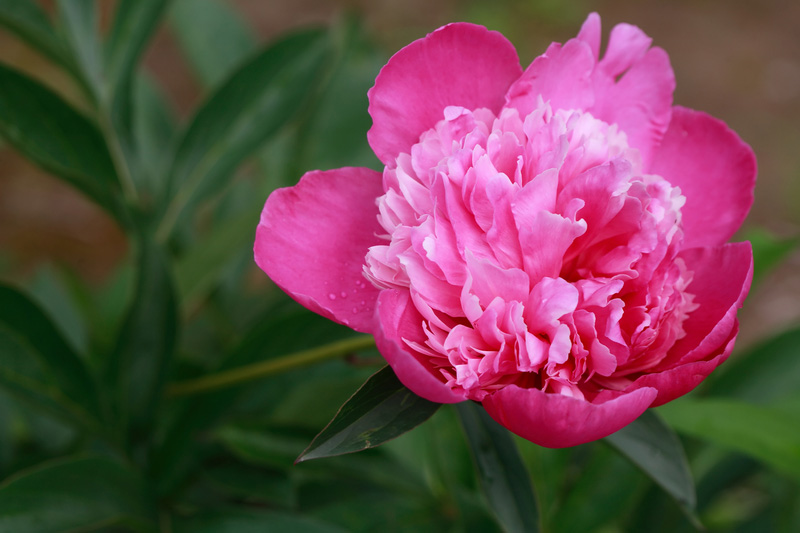Centuries ago in the gardens of the Imperial Palace of some long-forgotten Dynasty, a gardener lovingly tended the beautiful peonies that flourished under his watchful eye, and in the ancient temple gardens of Kyoto, these lovely flowers have perfumed the air for many venerable ancestors. In 1814, peonies found their way to France, and the result was “peony mania,” and a few decades later the Royal Horticulture Society introduced several varieties of peonies to the British Isles. By the turn of the century, peonies had found their way to America and were mainstays of grandmother’s garden.

Growing up in rural north Mississippi, most of the folks who grew peonies were country folk. Handed down as pass-along plants for generations, peonies were usually blooming the first week in May, just in time for Mother’s Day. Considered to be an old-fashioned flower, peonies fell out of favor with many sophisticated gardeners. The late garden columnist Henry Mitchell chastised a reader for complaining about the ephemeral nature of these exquisite flowers and advised she take a week off to revel in the beauty of these magnificent garden flowers. Fads may come and go, but the peony’s beauty is enduring.
Because peonies require cold winters, many Southern gardeners are wary of planting peonies, but do not let that discourage you. There are many varieties that flourish in the South, even in Zone 8, and if planted properly and in the right location, they will last for centuries.

Peonies for Mississippi Gardens
In north Mississippi there are more varieties of peonies to choose from, while in south Mississippi the choices are more limited. However, if planting peonies for the first time, I would begin with the tried and true, the peonies your grandmother probably grew. Three fail-proof, trouble-free varieties of peonies are:
1. Festiva Maxima-Introduced in 1851, it is a double white, fragrant peony with flecks of crimson.
2. Sarah Bernhard-Introduced in 1906, it is a lush, fragrant double pink peony.
3. Monsieur Jules Elie-a double rose-pink peony.

More Peonies for The Deep South
1. Karl Rosenfield-This peony has double deep pink to red blooms.
2. Buckeye Belle-This is a semi-double peony with velvety, dark red blooms.
3. Shirley Temple-This is a huge, double white peony with hints of rose.
4. Gardenia-These are very fragrant, double white peonies.
5. Big Ben-This peony was introduced in 1943. It is rose red.
6. Kansas-This peony has double, carmine red blooms.

How to Grow Peonies
Peonies are grouped according to shape. They can be single, semi-double, anemone, or double flower forms. Peonies only bloom for about two weeks, but by planting early and midseason varieties, the bloom time can be extended. Select varieties that will grow best in your plant zone.
Fall is the best time to plant peonies, especially tubers, but container-grown peonies can be planted in spring or fall. Most gardeners plant peonies in full sun, but some seem to think they fare better in our hot summers if they get a little dappled afternoon shade. Peonies should not be planted deep, and if planting tubers, the tubers should be planted only an inch or two below the soil with the eyes up. If planting in rows, plant about two feet apart. Just remember, peonies do not like to be moved, so plant them in a permanent location.
Peonies should be watered after planting. In the spring there should be adequate moisture, but during times of drought or during hot summers, it is advisable to water them about every two weeks.
In the summertime, peonies should be mulched to protect them from the intense heat of our summers, but the mulch should be removed in the winter so that the roots are exposed to the cold. Peonies must have a cold spell to thrive.
When it comes to fertilizer, less is better. If too much fertilizer is applied, there will be more foliage than flowers. Some gardeners recommend an annual application of bone meal, but peonies, once established, seem to thrive on just the bare minimum.
Peonies are susceptible to few diseases and are relatively pest free. Peonies do seem to attract ants, but the ants are harmless and discourage the presence of more harmful insects. There really is no need to spray and obliterate either the ants or the wonderful fragrance.

Peonies as cut flowers
Peonies are excellent cut flowers. Cut peonies early in the morning and immediately immerse in cool water. (Be sure to leave at least one-third of the blossoms on the plant for future flower production.) Let the peonies hydrate, then recut under water before arranging in a vase. Budded peonies may be cut before they are fully opened, wrapped in moist newspaper, and stored in the refrigerator for a couple of weeks. If storing in a refrigerator, remember that all other fruits and vegetables give off a gas that will wilt the flowers.
In floral arrangements, peonies can be used with other flowers but are probably at their loveliest when the arrangement is not too contrived. Peonies are perfect for an heirloom crystal or porcelain vase.
Peonies, throughout the ages, have inspired artists. Peonies have adorned antique silk screens and kimonos, and the old masters tried to capture the beauty of these flowers in still-life paintings. But nothing compares to the beauty and fragrance of peonies in the garden or in a floral arrangement.





